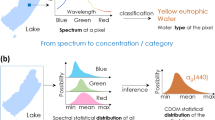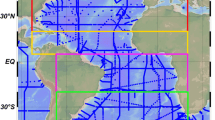Abstract
The probabilistic continuous constraint framework complements the representation of uncertainty by means of intervals with a probabilistic distribution of values within such intervals. This paper describes how nonlinear inverse problems can be cast into this framework, highlighting its ability to deal with all the uncertainty aspects of such problems. In previous work we have formalized the framework, relying on simplified integration methods to characterize the uncertainty distributions. In this paper we (1) provide validated constraint-based algorithms to compute these distributions, (2) discuss approximations obtained by their hybridization with Monte-Carlo methods, and (3) obtain a better uncertainty characterization, by including methods to compute expected values and standard deviations. The paper illustrates this new methodology in Ocean Color (OC), a research area which is widely used in climate change studies and has potential applications in water quality monitoring. OC semi-analytical approaches rely on forward models that relate optically active seawater compounds (OC products) to remote sensing measurements of the sea-surface reflectance. OC products are derived by inverting the forward model on a spectral-reflectance basis. Based on a set of preliminary experiments we show that the probabilistic constraint framework is able to provide a valuable characterization of the uncertainty of all scenarios consistent with the model and the measurements. Moreover, the framework can be used to derive how measurements accuracy affects the uncertainty distribution of the retrieved OC products, which may constitute an important contribution to the OC community.
Similar content being viewed by others
References
Alrefaei, M.H., & Abdul-Rahman, H.M. (2008). An adaptive Monte Carlo integration algorithm with general division approach. Mathematics and Computers in Simulation, 79, 49–59.
Arnone, R., et al. (2006). Remote sensing of inherent optical properties: fundamentals, tests of algorithms, and applications. IOCCG Report, 5(5), 1–122.
Bates, D.M., & Watts, D.G. (1988). Nonlinear regression analysis and its applications. Wiley series in probability and mathematical statistics. New York: Willey.
Bates, D.M., & Watts, D.G. (1988). Nonlinear regression: Iterative estimation and linear approximations (pp. 32–65). New York: Wiley.
Benhamou, F., & Goualard, F. (2000). Universally quantified interval constraints. In Principles and practice of constraint programming (pp. 67–82).
Benhamou, F., Goualard, F., Granvilliers, L., Puget, J.-F. (1999). Revising hull and box consistency. In Procs. of ICLP (pp. 230–244). Cambridge: MIT.
Benhamou, F., McAllester, D., van Hentenryck, P. (1994). CLP(intervals) revisited. In ISLP (pp. 124–138). Cambridge: MIT Press.
Berz, M., & Makino, K. (1999). New methods for high-dimensional verified quadrature. Reliable Computing, 5, 13–22.
Bistarelli, S., Montanari, U., Rossi, F. (1995). Constraint solving over semirings. In Proc. IJCAI95 (pp. 624–630). San Mateo: Morgan.
Carvalho, E., Cruz, J., Barahona, P. (2008). Probabilistic continuous constraint satisfaction problems. In ICTAI (2) (pp. 155–162).
Carvalho, E., Cruz, J., Barahona, P. (2010). Reasoning with uncertainty in continuous domains. In Integrated uncertainty management and applications. Advances in intelligent and soft computing (Vol. 68, pp. 357–369). New York: Springer.
Dubois, D., Fargier, H., Prade, H. (1993). The calculus of fuzzy restrictions as a basis for flexible constraint satisfaction. In Second IEEE international conference on fuzzy systems, 1993 (Vol. 2, pp. 1131–1136).
Fargier, H., & Lang, J. (1993). Uncertainty in constraint satisfaction problems: a probabilistic approach. In Proc. of ECSQARU. LNCS (Vol. 747, pp. 97–104). Berlin: Springer.
Fargier, H., Lang, J., Martin-Clouaire, R., Schiex, T. (1995). A constraint satisfaction framework for decision under uncertainty. In Proc. of the 11th int. conf. on uncertainty in artificial intelligence (pp. 175–180).
Granvilliers, L., & Benhamou, F. (2006). Algorithm 852: realpaver: an interval solver using constraint satisfaction techniques. ACM Transactions on Mathematical Software, 32(1), 138–156.
Granvilliers, L., Cruz, J., Barahona, P. (2004). Parameter estimation using interval computations. SIAM Journal on Scientific Computing, 26(2), 591–612.
Halpern, J.Y. (2003). Reasoning about uncertainty. Cambridge: MIT.
Hammersley, J.M., & Handscomb, D.C. (1964). Monte Carlo methods. London: Methuen.
Jaulin, L., Kieffer, M., Didrit, O., Walter, E. (2001). Applied interval analysis. New York: Springer.
Jaulin, L., & Walter, E. (1993). Set inversion via interval analysis for nonlinear bounded-error estimation. Automatica, 29(4), 1053–1064.
Kalos, M., & Whitlock, P. (2009). Monte Carlo methods. New York: Wiley.
Kreinovich, V. (2004). Probabilities, intervals, what next? Optimization problems related to extension of interval computations to situations with partial information about probabilities. Journal of Global Optimization, 29(3), 265–280.
Lee, Z., Arnone, R., Hu, C., Werdell, P.J., Lubac, B. (2010). Uncertainties of optical parameters and their propagations in an analytical ocean color inversion algorithm. Applied Optics, 49(3), 369–381.
Lhomme, O. (1993). Consistency techniques for numeric CSPs. In Proc. of the 13th IJCAI (pp. 232–238).
Maritorena, S., & Siegel, D.A. (2005). Consistent merging of satellite ocean color data sets using a bio-optical model. Remote Sensing of Environment, 94(4), 429–440.
McClain, C.R., Feldman, G.C., Hooker, S.B. (2004). An overview of the SeaWiFS project and strategies for producing a climate research quality Global ocean bio-optical time series. Deep Sea Research Part II: Topical Studies in Oceanography, 51(1–3), 5–42.
Menke, W. (1989). Geophysical data analysis: Discrete inverse theory (2nd ed.). New York: Academic Press.
Moore, R. (1966). Interval analysis. Englewood Cliffs: Prentice-Hall.
Morel, A., & Prieur, L. (1977). Analysis of variation in ocean colour. Limnology and Oceanography, 22, 709–722.
Robinson, I.S. (2010). Discovering the ocean from space. New York: Springer.
Sam-Haroud, D., & Faltings, B. (1996). Consistency techniques for continuous constraints. Constraints, 1(1/2), 85–118.
Shazeer, N., Littman, M., Keim, G. (1999). Constraint satisfaction with probabilistic preferences on variable values. In Proc. of national conf. on AI.
Tarantola, A. (2004). Inverse problem theory and methods for model parameter estimation. Philadelphia: SIAM.
Walsh, T. (2002). Stochastic constraint programming. In ECAI (pp. 111–115). Amsterdam: IOS Press.
Wang, P., Boss, E.S., Roesler, C. (2005). Uncertainties of inherent optical properties obtained from semianalytical inversions of ocean color. Applied Optics, 44(19), 4074–4085.
Wolfram Research, Inc. (2010). Mathematica edition: Version 8.0. Champaign: Wolfram Research, Inc.
Zibordi, G., & Voss, K. (2010). Field radiometry and ocean colour remote sensing. In V. Barale, J. Gower, & L. Alberotanza (Eds.), Oceanography from space (Chapter 18, pp. 307–334). New York: Springer.
Author information
Authors and Affiliations
Corresponding author
Rights and permissions
About this article
Cite this article
Carvalho, E., Cruz, J. & Barahona, P. Probabilistic constraints for nonlinear inverse problems. Constraints 18, 344–376 (2013). https://doi.org/10.1007/s10601-012-9139-6
Published:
Issue Date:
DOI: https://doi.org/10.1007/s10601-012-9139-6




